Day 3, the last day, of a long weekend of Spring Migration tours today. After exploring the east and the centre of the North Norfolk coast, it was time to go west. It was hailing and sleeting just before we met up this morning. Thankfully it was just a squally shower which passed over quickly on the blustery NW wind. The weather was forecast to improve, so we thought we would start up on the Wash looking for waders, before we went looking for passerine migrants which might be hiding in the rain.
The birding starts already on the way though – we often see birds from the car. We headed off cross country and had not gone too far when we noticed a Little Owl perched on the top of a barn roof ahead of us. We stopped the car and it looked at us for a few seconds wondering what to do, before flying off.
We were almost at our first destination when a white shape in the hedge caught the eye. It might have been a piece of wind-blown rubbish, but when we managed to pull over on the busy road we could see it was indeed a Barn Owl. It had found a spot out of the wind and was dozing in the morning sun.
 Barn Owl – dozing in the morning sun
Barn Owl – dozing in the morning sun
Up on the Wash, the tide was just starting to go out. It was not one of the biggest tides of the month, but was still pretty substantial and most of the mud had been covered with water. Over in the far corner, on the last bit of mud which had remained, we could see a huge gathering of waders. Through the scope, we could see a vast mass made up of thousands and thousands of grey blobs.
We had a quick look in Rotary Hide while we waited for the bulk of the waders to wake up and follow the outgoing tide down. There were quite a lot of Black-tailed Godwits on the pits, most over on the bank but a good number on one of the islands. Next to the latter was a small (by Wash standards!) huddle of Knot. There were also loads of Oystercatcher down at the far end and a party of Redshank too.
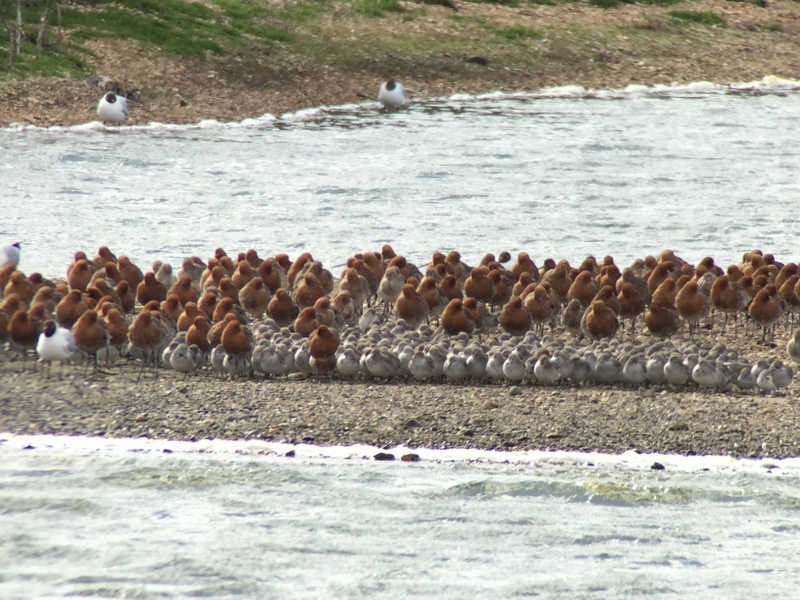 Black-tailed Godwits & Knot – roosting on the pits over high tide
Black-tailed Godwits & Knot – roosting on the pits over high tide
There were several smaller flocks of Oystercatcher out on the Wash which were first to fly and follow the tide out. When the large flock of waders took off, we went back outside to watch them. They looked like an enormous dark grey cloud blowing low across the mud. With nothing chasing after them, they didn’t swirl around at first but landed back down on the mud nearer the tideline. Through the scope we could see they were mostly Knot, tens of thousands of them, plus good numbers of Grey Plover and Bar-tailed Godwit too.
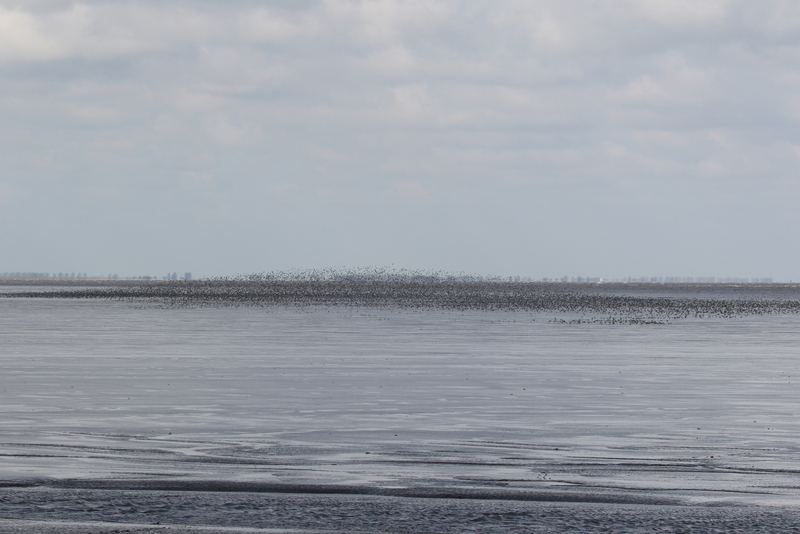
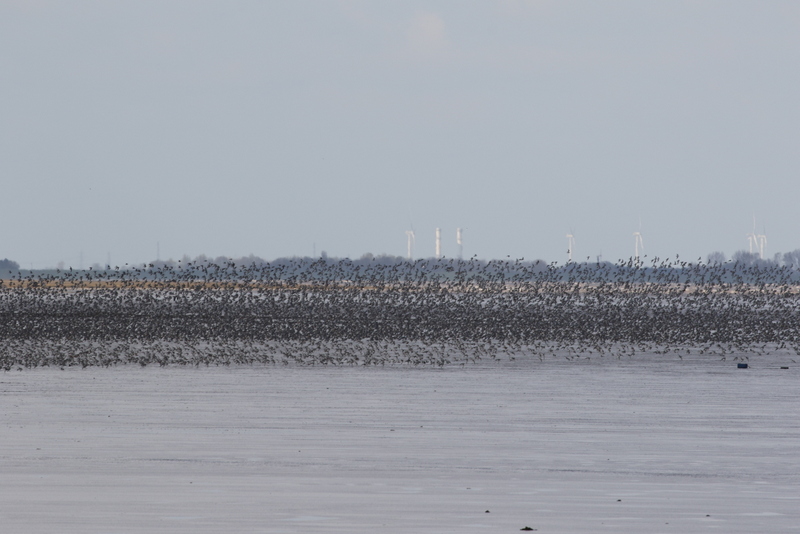 Waders – the vast flock following the outgoing tide down
Waders – the vast flock following the outgoing tide down
While we were outside, we heard a Cuckoo calling from the bushes along the bank by the hide. We just caught a glimpse of it as it flew off and it seemed to land again back close to where we had parked. We walked back and the Cuckoo came out of the bushes again and flew off across the water. It perched for a second or two on a concrete block, before flying off behind the bushes.
There were lots of waders now feeding feverishly out on the mud. As well as the ones already mentioned, there were plenty of Dunlin, plus a few Ringed Plover and the odd Turnstone too. The vast flock of Knot and other waders took off a couple more times to move closer to the shore, with a good part of it at one point doing some aerial manoeuvres. Eventually, the waders starting to come of the pits too. The Oystercatchers came over first, followed by the Redshanks, in dribs and drabs. As two birds came up over the bank, one of them called, a distinctive ‘tchueet’, the unmistakable call of a Spotted Redshank. We looked up to see a lovely blackish bird flying over with a much greyer Redshank.
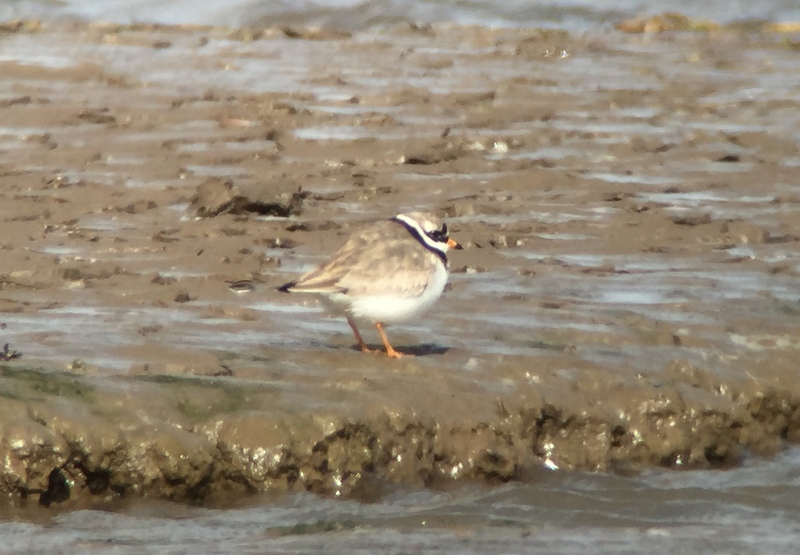 Ringed Plover – out on the mud of the Wash
Ringed Plover – out on the mud of the Wash
With the weather improving now, we set off back to Snettisham Coastal Park. As we walked out, there were lots of warblers singing from the bushes – Blackcap, Lesser Whitethroat, Common Whitethroat, Sedge Warbler, Cetti’s Warbler, Chiffchaff and Willow Warbler. Quite a selection! Then, to cap it off, we heard a Grasshopper Warbler reeling – the distinctive song which consists of a rattling series of very fast clicks. Unfortunately it was singing from deep in an impenetrable area of wet reeds and bushes.
A second Cuckoo flew past low over the bushes, flushing all the finches as it did so. A trickle of House Martins flew over, heading north. Then one of the group spotted a small bird flick up into a bush. It was a female Common Redstart – as it flew again, we could see its bright orange-red tail. Unfortunately, it disappeared deep into cover before the rest of the group could get onto it and didn’t reappear, even after we had sheltered out a brief passing shower. We decided to have another look here on our way back.
The middle section of the Coastal Park was a little quiet, apart from the occasional warbler, but when we got up towards the north end, we heard another Grasshopper Warbler reeling. It was very quiet and seemed to be a long way off, but we walked in the direction of the sound up to a clump of brambles. As we approached, we saw a promising looking shape fly in but the reeling at first still seemed to be further away. Then suddenly it hopped up onto a branch of the brambles right in front of us. Stunning!
 Grasshopper Warbler – hopped up in front of us, reeling
Grasshopper Warbler – hopped up in front of us, reeling
The Grasshopper Warbler was being blown around in the wind, but still stayed up in the top for a good time, giving us plenty of opportunity to get a good look at it. Then it dropped back down and went silent.
The walk round the top of the Park did not yield anything new, and we turned and started to walk back along the inner seawall. A flock of House Martins and Swallows were hawking for insects around some cows on the bank a little further along. There were a few ducks on the grazing meadows – Shelduck, Gadwall, a single Wigeon and a Mallard with ducklings. There was no sign at first of the little group of Pink-footed Geese we have seen here recently. But a careful scan as we walked revealed a dark head down in the grass and it eventually stood up and walked across. It was a Pink-footed Goose, but it appeared to be sick or injured, which would explain why it was not joining its mates on the long journey back north.
When all the gulls and ducks took off from the grazing marshes in a panic, we turned to see a large female Peregrine scything down through the flocks. It made a couple of passes, but came up empty talonned each time. Then it circled up high over Ken Hill Wood before drifting off back towards the Wash.
We cut across back to where we had seen the Redstart earlier, flushing a couple of Common Snipe from the wet grass by a large puddle on the way. As we rounded the corner, the Redstart flicked off into the low trees again. We played a game of cat and mouse for a while before it finally came out well enough for all the group to get onto it. A nice bird to catch up with today.
Our next destination was Titchwell, but on the way we made a short detour to see the Fulmars hanging over the clifftop in Hunstanton. As we drove round the coast, we happened to spot a lone Whimbrel on the cricket pitch at Thornham, so we pulled in to have a quick look at it, before it flew off.
 Whimbrel – on the cricket pitch at Thornham
Whimbrel – on the cricket pitch at Thornham
After lunch at Titchwell, we headed out to explore the reserve. The feeders in front of the visitor centre were rather quiet, but those round the back held a selection of finches – Chaffinches, Goldfinches and Greenfinches – at least until the Jackdaws moved in and scared everything off. The Water Rail was in its usual ditch again, but took a bit of finding today as it was tucked down in the most overgrown stretch, under the near bank. We followed it for a while as it made its way along the edge of the water and eventually came out into the open where we could get a great view of it.
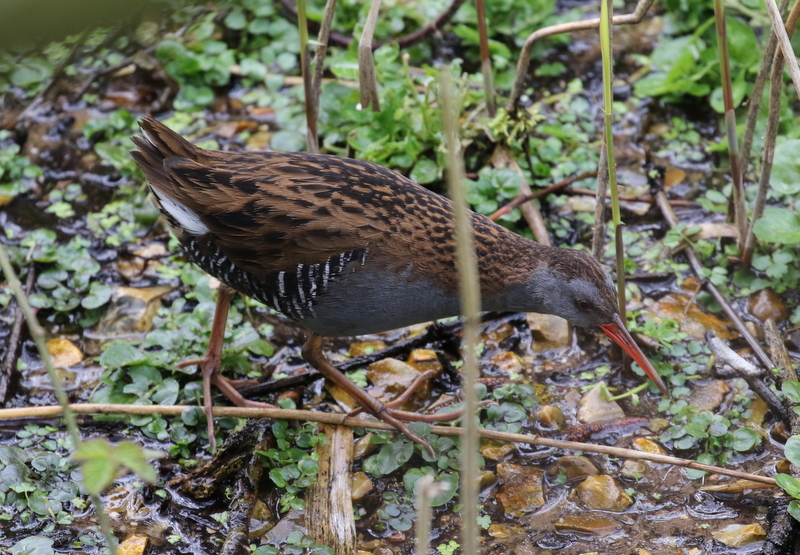 Water Rail – in the ditch as usual
Water Rail – in the ditch as usual
From the main path by the reedbed, we could hear warblers singing out in the reeds. A Reed Warbler was hard to hear behind the barrage of whistles and buzzy phrases pouring out from a nearby Sedge Warbler which perched up nicely in a small sallow for us. Only when the Sedge Warbler occasionally paused for breath could we hear the quieter, more rhythmic song of the Reed Warbler behind. The Reed Warblers are only now returning from Africa where they have spent the winter and this one seemed yet to get into full voice. Periodically, a Cetti’s Warbler would shout at us from the bushes too.
The grazing meadow ‘pool’ remains mostly dry, although the recent rain has topped up the puddles. There were several Pied Wagtails on here today and in with them we picked out at least three White Wagtails as well – their silvery grey backs setting them apart from the black or slaty-grey backed Pieds. A pair of Little Ringed Plover dropped in too and through the scope we got a good view of the golden yellow eyering on one of them.
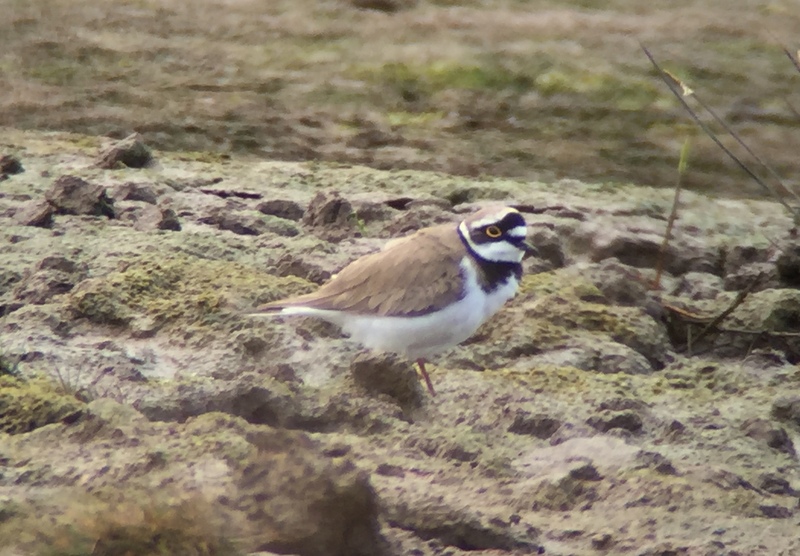 Little Ringed Plover – on the grazing meadow ‘pool’
Little Ringed Plover – on the grazing meadow ‘pool’
Out on the deeper reedbed pool, we could see a single drake Red-crested Pochard, showing off his bright orange punk haircut and coral red bill. A female Common Pochard was preening by the reeds at the front and a male was sleeping nearby. We stopped to watch the Marsh Harriers quartering over the reedbed and could hear Bearded Tits calling. This is often a good spot to watch hirundines hawking for insects in windy weather, but there were none here on our walk out.
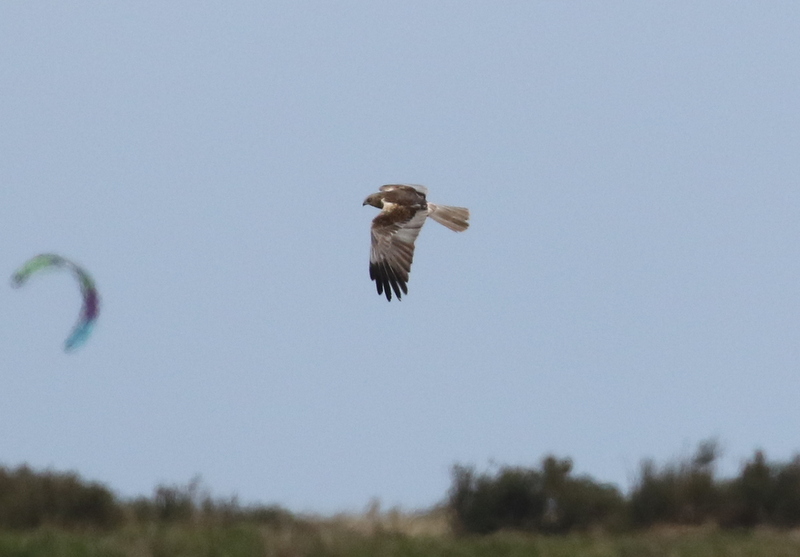 Marsh Harrier – a male, over the reedbed
Marsh Harrier – a male, over the reedbed
The water level on the freshmarsh has gone up again, perhaps due to the recent rain. We popped into Island Hide but with little exposed mud over this side there was not much here today. A pair of Common Teal were swimming right outside and the drake was looking very smart.
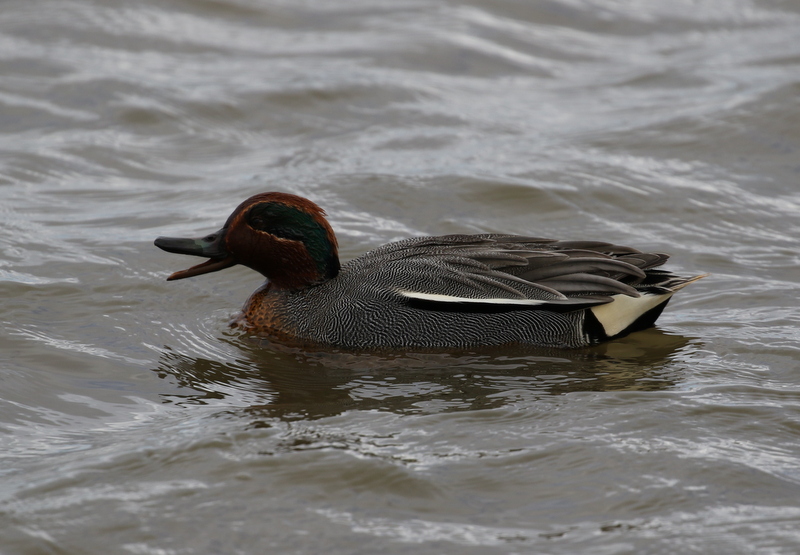 Common Teal – in front of Island Hide
Common Teal – in front of Island Hide
The Avocets normally steal the show here and a pair obliged us by feeding just in front of the hide. They were struggling a bit, up to their bellies in the deep water, but it was just possible to see that they were still sweeping their bills from side to side deep underwater by the movement of their tails! A little party of Black-tailed Godwits, most in bright orange breeding plumage, were sleeping further over by one of the islands.
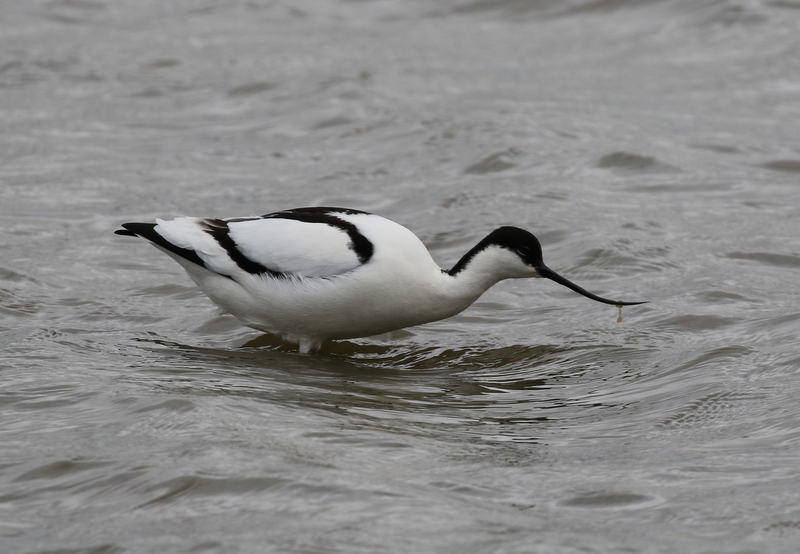 Avocet – feeding in the deep water in front of Island Hide
Avocet – feeding in the deep water in front of Island Hide
We made our way round to Parrinder Hide to have a look from the other side. There had been a Little Stint and Common Sandpiper here for the last couple of days, but there was no sign of them when we arrived. They often seem to disappear round the back of the islands, so while we waited for them to come out, we admired the pair of Shoveler below the hide. They would occasionally raise their heads from the water and indulge in a quick bout of synchronised head bobbing display. The drake was also quite aggressive, chasing off any Gadwall and Teal that came too close. An adult Mediterranean Gull flew over the bank, calling.
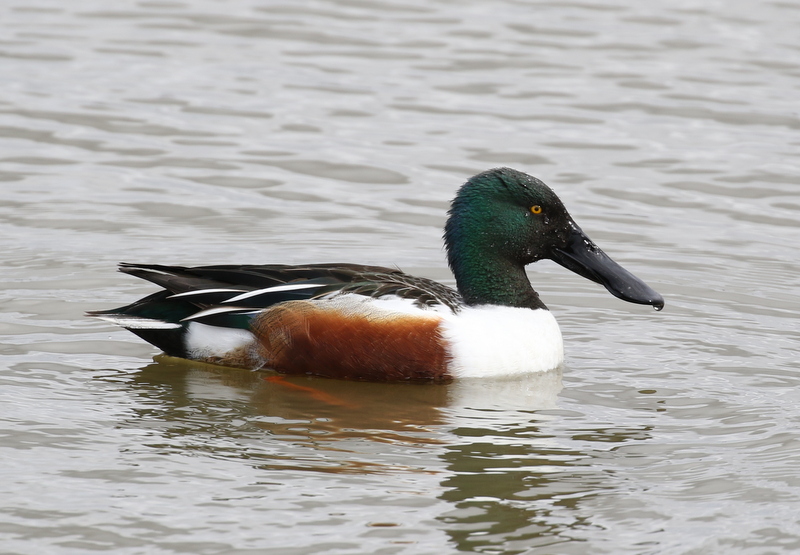 Shoveler – the drake from Parrinder Hide
Shoveler – the drake from Parrinder Hide
It didn’t take too long for the Little Stint to put in an appearance, on the small island inside the new ‘Avocet fence’. We could immediately see how small it was, creeping around on the mud, but that was made even more obvious when it flew over to the bank and joined a couple of Little Ringed Plovers, which it dwarfed. Then the Common Sandpiper appeared on the bank too and walked back past them. At one point, we had the three species in the scope together.
 Little Stint – on one of the islands inside the new fence
Little Stint – on one of the islands inside the new fence
With the main targets here acquired, we headed on towards the beach. The Volunteer Marsh and Tidal Pools were rather quiet again today, so we went straight out to look at the sea. On our way, a small warbler flew in along the path and disappeared inland – presumably a freshly arrived Willow Warbler.
It was rather cold and exposed on the beach, despite some sunshine, given the north wind blowing, so we didn’t hang around too long out here. A small raft of Common Scoter was bobbing about in the waves a short distance offshore. There were lots of gulls along the shoreline and in among their legs we could see several little Sanderling running around in and out of the waves.
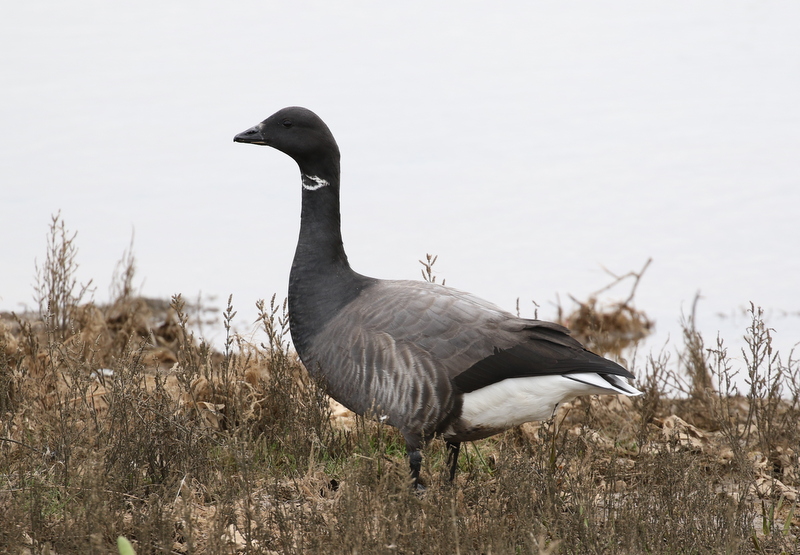 Brent Goose – a pair had appeared on the Tidal Pools
Brent Goose – a pair had appeared on the Tidal Pools
On the walk back, a pair of Brent Geese had appeared on the near edge of the Tidal Pools, giving us some nice close-up views. Then back at the reedbed pool, as we stopped to have another scan, a couple of Common Swifts appeared, hawking for insects over the reeds with a Swallow or two. These are the first Swifts we have seen this year. A Great Crested Grebe was lurking at the very back of the pool and a Little Grebe appeared nearby briefly too. A Bearded Tit ‘pinged’ and shot off over the tops of the reeds all the way over towards Fen Hide.
We detoured round to have a quick look at Patsy’s Reedbed. On the way, a Willow Warbler was singing from the sallows along Meadow Trail. There were not many birds on Patsy’s itself, a few Greylag Geese and commoner ducks, but two drake Red-crested Pochard were sleeping on here this afternoon. We could still see the two Common Swifts and a couple of Marsh Harriers over the reedbed beyond. A pleasant spot to end the day.
















